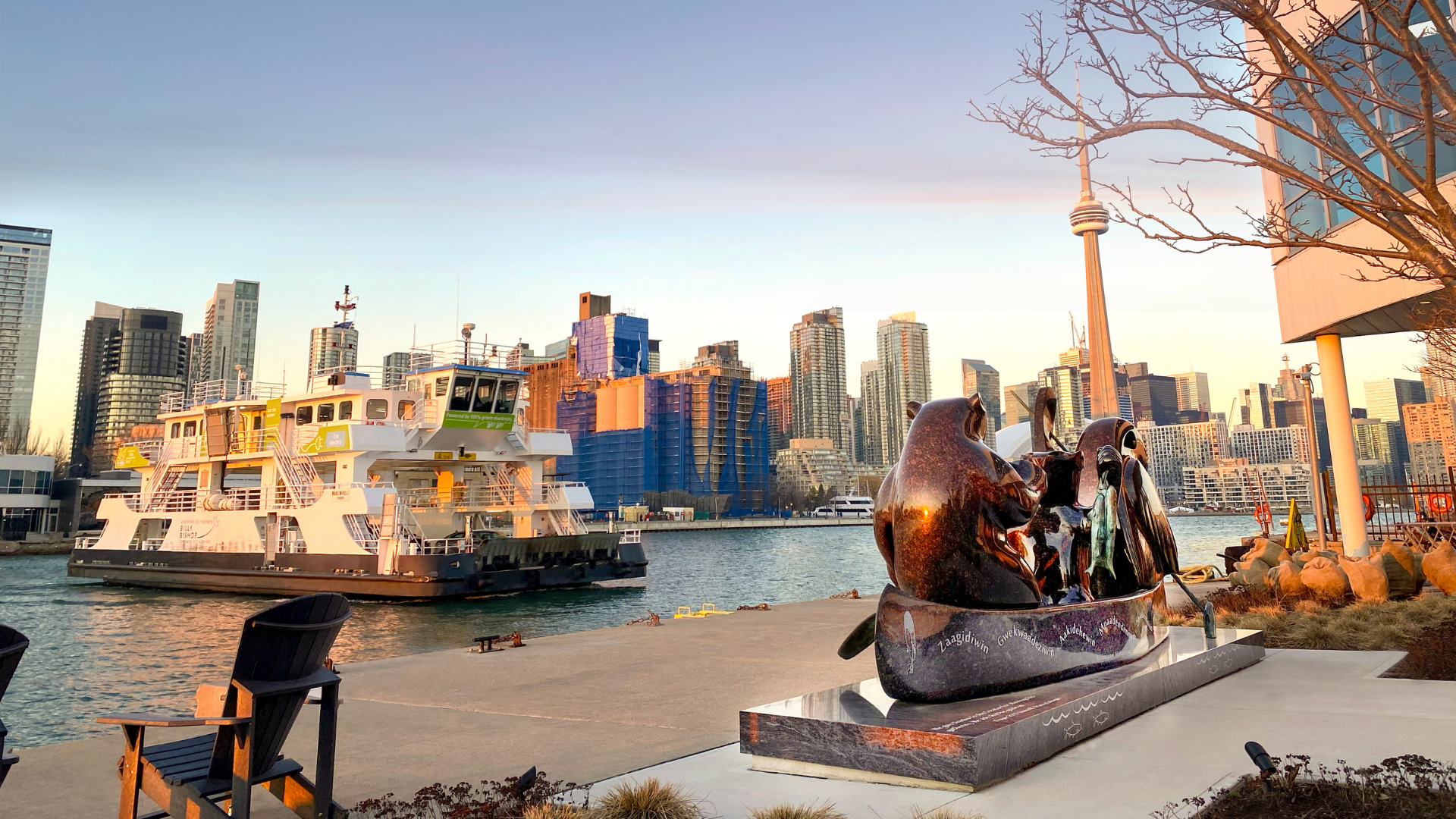
Art at YTZ
Art and culture is proudly represented at Billy Bishop Toronto City Airport.
Art and culture is proudly represented at Billy Bishop Toronto City Airport. In recognition of our commitment to celebrating and supporting local artists, as well as reflecting the diversity and vibrancy of our community, the airport hosts a number of permanent and temporary art installations.

Maanjidowin: The Gathering
Artist: David M. General
Location: Dock wall overlooking the Western Gap
Commissioned by PortsToronto in recognition of the Mississaugas of the Credit First Nation and their relationship to the land, air and water on which Billy Bishop Toronto City Airport now operates.
This large-scale granite and bronze sculpture features three mythical fishers – Makwa-Kwe (Bear), Nigig-Kwe (Otter) and Migizi-Kwe (Eagle) – who have come to the estuaries and islands along Toronto’s Lake Ontario shoreline to fish. The canoe in which the fishers sit is inscribed with words and symbols of significance to the Mississaugas of the Credit, including: The Medicine Wheel; the Seven Grandfather Teachings, which are guiding principles that provide the moral and cultural foundation of life; and poetry from the current Chief R. Stacey Laforme. As indicated by inscribed arm tattoos, the creatures are all female, as females played a central role as custodians of cultural traditions surrounding water.
The sculpture was created by David M. General, Mohawk Nation, Wolf Clan of the Six Nations, who is known for blending Indigenous and modernist styles and typically working with stone.
Learn more about Maanjidowin: The Gathering here.
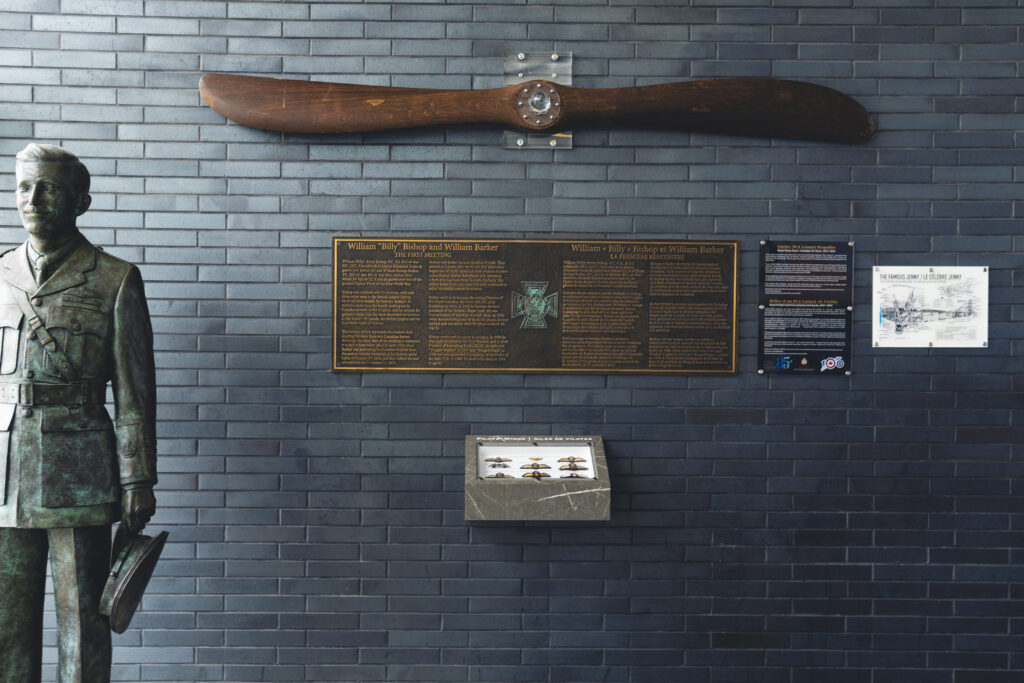
RCAF Centennial Exhibit
Location: Mainland Pavilion
In April 2024, a new permanent exhibit was unveiled at Billy Bishop Toronto City Airport in collaboration with the Royal Canadian Military Institute (RCMI) and RCAF Foundation to commemorate the RCAF centennial and 85th anniversary of the airport. This exhibit features an original First World War-era Curtiss JN-4 Canuck biplane propeller. The “Canuck”, manufactured by Canadian Aeroplanes Ltd. of Toronto was widely used in training by Canadian pilots during the First World War. It also includes a collection of nine original pilot’s wings badges, representing the evolution of badges worn by Canadian aviators from 1912-present and including the rare Royal Flying Corps (RFC) and Royal Naval Air Service (RNAS) wings of the First World War.
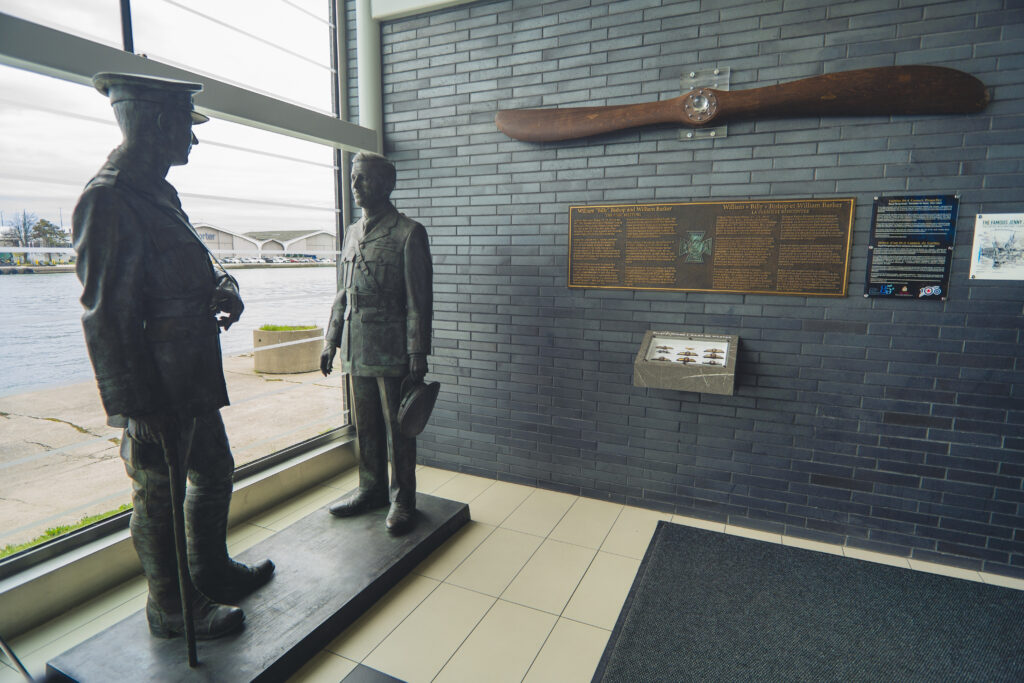
William “Billy” Bishop and William Barker – The First Meeting
Artist: George Batholomew Boileau
Location: Mainland Pavilion
Installed in 2015 to commemorate the pedestrian tunnel opening, the life-size bronze statues represent the historic first meeting between the airport’s namesake – William “Billy” Bishop – and William Barker, two Canadian flying aces of the First World War and Victoria Cross recipients. Although the exact date of the meeting is unknown, it is said to have taken place in early 1919. Bishop and Barker went on to become steadfast friends and upon returning from the war, began one of North America’s first aviation charters called Bishop-Barker Aeroplanes Ltd, as well as helped establish Billy Bishop Toronto City Airport – then named Port George VI Airport, Toronto’s first airport, in 1939.
The statues were created by artist George Batholomew Boileau. Artcast Inc. then created a bronze cast of Boileau’s original sculpture using the lost-wax process.
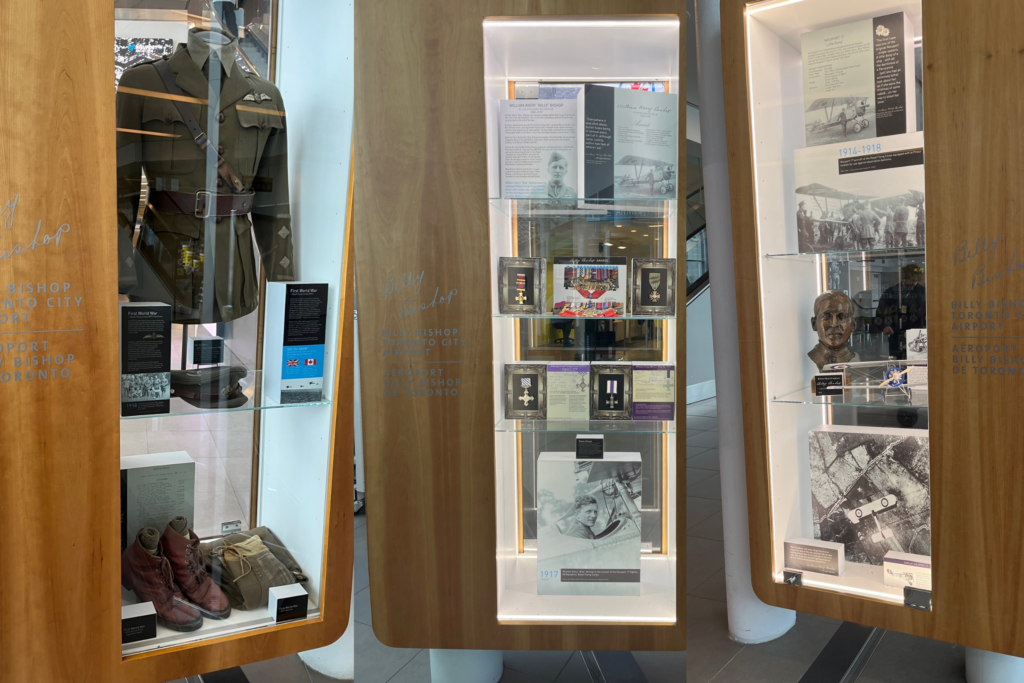
Billy Bishop Memorial Exhibit
Location: On the arrivals level of the passenger terminal
Located on the arrivals level of the passenger terminal, this exhibit is dedicated to the airport’s namesake – William Avery “Billy” Bishop, one of Canada’s most successful flying aces and recipient of the Victoria Cross. The exhibit was created in collaboration with the Bishop House and Museum in Owen Sound and the Canadian War Museum in Ottawa and features display cases with artifacts and memorabilia, along with a photographic retrospective that doubles as a seating area. The Billy Bishop memorial exhibit was originally unveiled in 2015 and was updated in 2024.
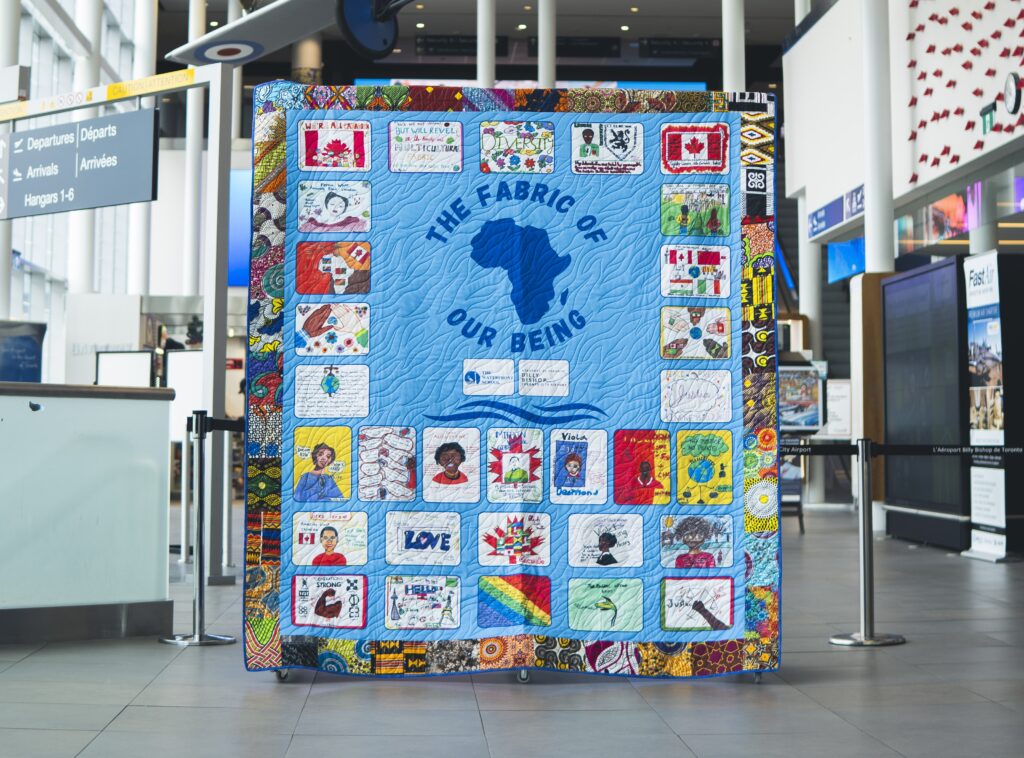
The Fabric of Our Being
Artists: Nadine Williams, Grade Four students at The Waterfront School
Location: Departures level of the passenger terminal
The Fabric of Our Being is a poetry and textile art installation celebrating and bringing awareness to the International Decade for People of African Descent, a United Nations initiative. It was conceptualized by poet, author and arts educator, Nadine Williams and her Collective and features designs by grade four students of the Waterfront School. The quilt is composed of the student’s artwork based on four criterions, An Amazing Black Canadian, Mother Tongue, Recognition, Development, Justice and the poem “The Fabric of Our Being”, and a border that is made of fabric representing various regions of Africa.
Learn more about the Fabric of Our Being here.
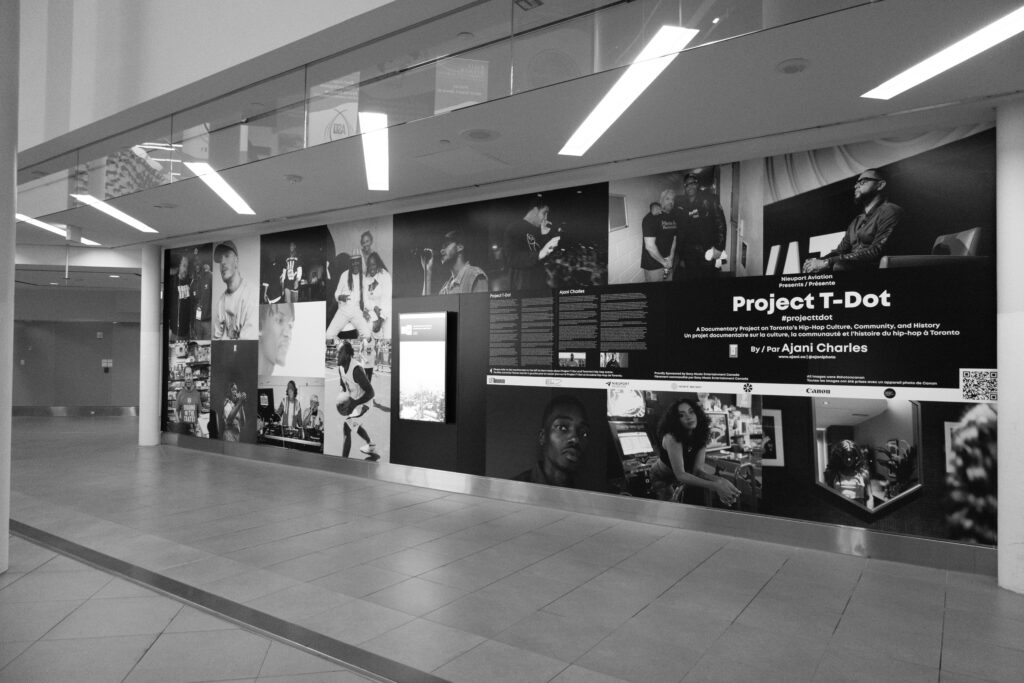
Project T-Dot
Artist: Ajani Charles
Location: On the arrivals level of the passenger terminal
In Project T-Dot, photographer Ajani Charles celebrates Toronto’s diverse Hip-Hop culture and community. Project T-Dot features 60-large scale photographic panels, depicting candid images of Toronto’s most renowned Hip-Hop figures, such as Drake, The Weeknd, Kardinal Offishall, Jully Black and Maestro Fresh Wes, among many others. Reflecting the diversity of the Hip-Hop subculture, the exhibit features members of the 2SLGBTQ+, Black, and Indigenous communities, women, youth from equity-deserving neighbourhoods, recent immigrants, and other marginalized groups.
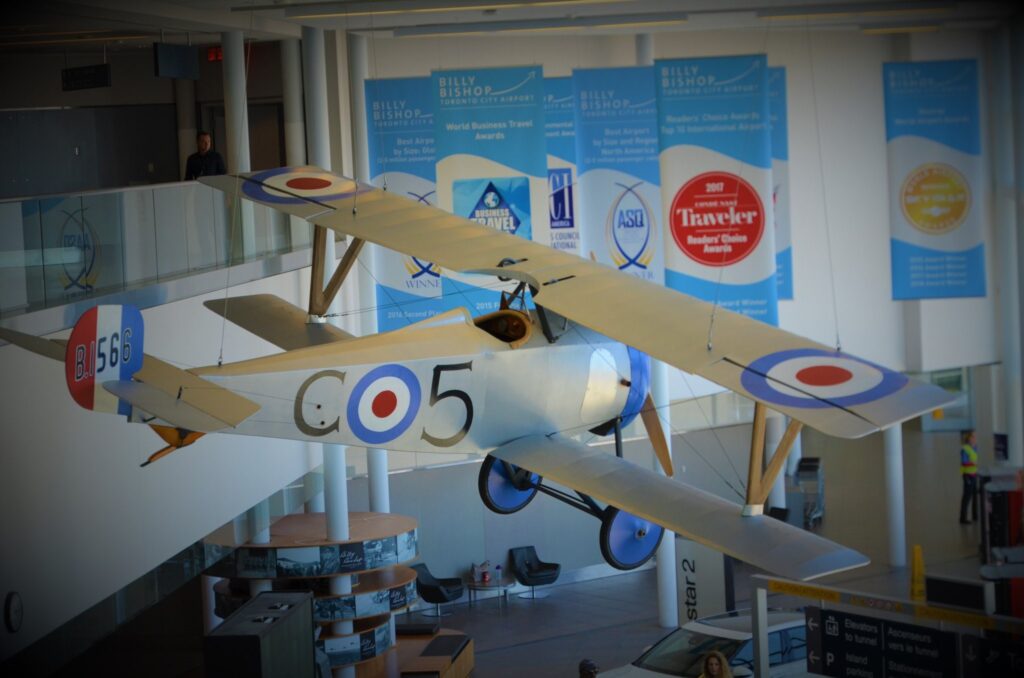
Nieuport 17 Model
Artist: Aidrome Aeroplanes
Location: On the arrivals level of the passenger terminal
This life-size model of a Nieuport 17 suspended from the ceiling of the passenger terminal was installed in 2015. With a wingspan of more than 26 feet and measuring more than 18 feet in length, the model took 1,200 hours to build and replicates nearly every detail of the Nieuport 17 that Billy Bishop piloted during the First World War. According to its builder Aidrome Aeroplanes, if the navigational equipment and engine were to be added to this model, it would be fully operational and could fly.

Bloody Boats
Artist: Akshata Naik
Location: On the arrivals level of the passenger terminal
Commissioned by Nieuport Aviation as part of ArtworxTO, ‘Bloody Boats’ is an art installation about deconstructing and dismantling the symbol of the traumatic journey that immigrants experience. This piece is as dynamic as an immigrant’s journey. The journey of a settler is not only a physical transition, but also a cognitive and social transition that revolves around multiple socio-political narratives. The repeated symbolic shape of a boat on a large scale resonates with the journey of an immigrant who moves for a better life, safe space, or a refugee whose displacement is the result of natural calamity or invasion.
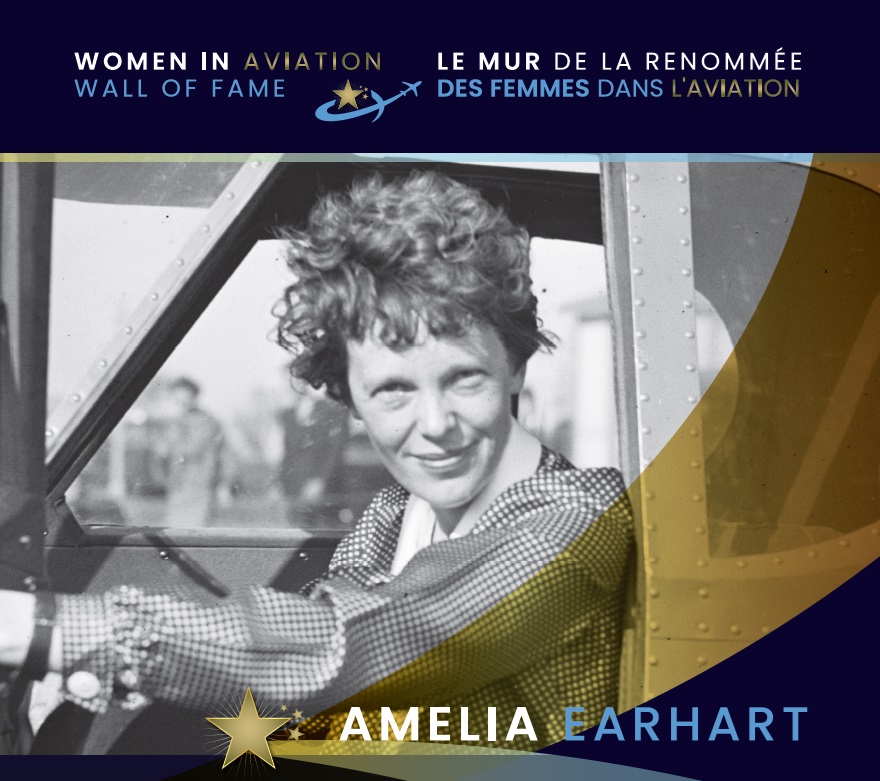
Women in Aviation Wall of Fame
Location: Departures level of the passenger terminal
The Women in Aviation Wall of Fame honours the extraordinary contributions of eight trailblazing women in aviation with connections to Toronto or Billy Bishop Toronto City Airport. Launched on March 8, International Women’s Day, Amelia Earhart is the inaugural Women in Aviation Wall of Fame honouree, whose visit to Toronto in 1917 ignited her passion for flight. A new inductee will be introduced every month and added to the gallery for the remainder of 2024. To learn more about the Women in Aviation Wall of Fame, click here.
Photo credit: Library of Congress, Prints & Photographs Division, photograph by Harris & Ewing, [reproduction number LC-DIG-hec-40747]

PowerON Charger
Artist: Roma Maré
Location: Mainland pavilion PowerON charger near the shuttle drop off
This artwork by Indigenous student artist, Roma Maré reflects the land’s history and its connection to the Indigenous community. The Eagle, prominently featured in this work, serves as the primary totem for the Mississaugas of the Credit First Nation, symbolizing its role as a messenger. The blue lines represent OPG’s 66 hydroelectric power plants across 24 river systems, representing that water is not just for hydration; it is sacred, alive, and possesses a spirit. The green line threading through the city represents the emissions-free electricity that powers modern life.

Bay of Spirits Contemporary First Nations Art Gallery
Artists: Brent Hardisty, Mark Seabrook, Kevin Pee-ace, Roy Thomas, Jay Bell Redbird, Isaac Bignell, and John Laford
Location: Departures level of the passenger terminal
This gallery brings together curated works from artists both local to the Greater Toronto Area and across Ontario, including Ojibway, Cree and Oji Cree peoples and it honours the Indigenous elders, leaders, artists and community members that have lived upon the lands the airport now operates on.
For more information on the artworks displayed, click here.

Moccasin Identifier Pillars
Artist: Karly Cywink
Location: Departures level of the passenger terminal
Billy Bishop Toronto City Airport is the first airport in Canada to support and host a Moccasin Identifier. The Moccasin Identifier, is a First Nations-led initiative that aims to cover Canada in Moccasins so that all Canadians understand Indigenous relationship to land and what it means to be a Treaty partner.
Located in the departures area of the Passenger Terminal, are four unique Moccasin Identifier pillars featuring the moccasins of the Seneca, Anishinaabe, Huron-Wendat, and Cree nations. Each design is unique to the nation and groups that created them, reflecting the diversity of the ancestral cultures that existed before the first settlers arrived.